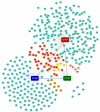Genome-Wide Mapping Reveals Complex Regulatory Activities of BfmR in Pseudomonas aeruginosa
- PMID: 33668961
- PMCID: PMC8025907
- DOI: 10.3390/microorganisms9030485
Genome-Wide Mapping Reveals Complex Regulatory Activities of BfmR in Pseudomonas aeruginosa
Abstract
BfmR is a response regulator that modulates diverse pathogenic phenotypes and induces an acute-to-chronic virulence switch in Pseudomonas aeruginosa, an important human pathogen causing serious nosocomial infections. However, the mechanisms of action of BfmR remain largely unknown. Here, using chromatin immunoprecipitation followed by high-throughput sequencing (ChIP-seq), we showed that 174 chromosomal regions of P. aeruginosa MPAO1 genome were highly enriched by coimmunoprecipitation with a C-terminal Flag-tagged BfmR. Integration of these data with global transcriptome analyses revealed that 172 genes in 106 predicted transcription units are potential targets for BfmR. We determined that BfmR binds to and modulates the promoter activity of genes encoding transcriptional regulators CzcR, ExsA, and PhoB. Intriguingly, BfmR bound to the promoters of a number of genes belong to either CzcR or PhoB regulon, or both, indicating that CzcRS and PhoBR two-component systems (TCSs) deeply feed into the BfmR-mediated regulatory network. In addition, we demonstrated that phoB is required for BfmR to promote the biofilm formation by P. aeruginosa. These results delineate the direct BfmR regulon and exemplify the complexity of BfmR-mediated regulation of cellular functions in P. aeruginosa.
Keywords: BfmRS; Pseudomonas aeruginosa; biofilm formation; regulon; two-component system.
Conflict of interest statement
The authors declare no conflict of interest.
Figures






References
-
- Tacconelli E., Carrara E., Savoldi A., Harbarth S., Mendelson M., Monnet D.L., Pulcini C., Kahlmeter G., Kluytmans J., Carmeli Y., et al. Discovery, research, and development of new antibiotics: The WHO priority list of antibiotic-resistant bacteria and tuberculosis. Lancet Infect. Dis. 2018;18:318–327. doi: 10.1016/S1473-3099(17)30753-3. - DOI - PubMed
LinkOut - more resources
Full Text Sources
Other Literature Sources
Molecular Biology Databases

